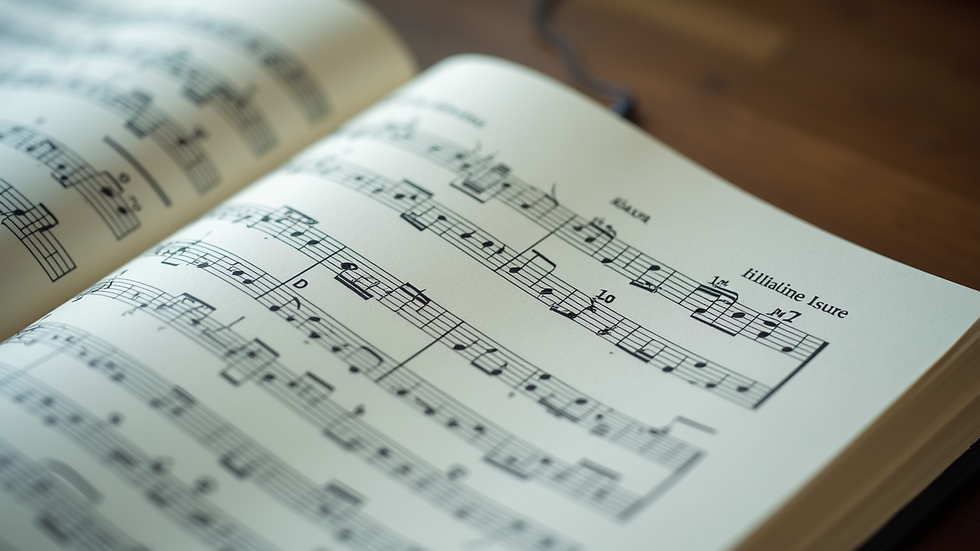Mastering the Nashville Number System for Music
- mandalynentertainm
- Aug 6
- 3 min read
Understanding how to read and write music efficiently is a valuable skill for any musician. One of the most effective tools for this is the Nashville Number System, a method that simplifies chord charts and makes transposing songs easier. This article will explore the fundamentals of this system, its practical applications, and tips for mastering it.
What Is Nashville Music Notation?
Nashville music notation is a shorthand method used by musicians to communicate chord progressions quickly and clearly. Instead of writing out chord names, this system uses numbers to represent chords based on their position within a key. For example, in the key of C major, the C chord is 1, D minor is 2, E minor is 3, and so on.
This system is especially popular in studio sessions and live performances because it allows musicians to adapt to different keys without rewriting the entire chart. It also helps bands and groups stay in sync when changing keys on the fly.
How It Works
Each number corresponds to a scale degree.
Major chords are represented by plain numbers (1, 4, 5).
Minor chords are often indicated with a minus sign or lowercase (2-, 3-).
Additional symbols can indicate chord qualities like seventh chords or suspensions.
This approach reduces confusion and speeds up communication among musicians.

Practical Applications of Nashville Music Notation
Using the Nashville Number System can transform how you approach playing and writing music. Here are some practical ways to apply it:
Transposing Made Simple
If you know a song in one key, you can easily transpose it to another key by shifting the numbers accordingly. For example, a 1-4-5 progression in C (C-F-G) becomes D-G-A in the key of D.
Quick Communication in Sessions
In recording studios or jam sessions, musicians often need to change keys or adjust arrangements quickly. The Nashville system allows everyone to follow along without confusion.
Writing and Learning Songs Faster
Instead of memorizing chord names, you can focus on the relationship between chords. This helps in understanding song structure and makes learning new songs faster.
Example Chart
| Number | Chord in C Major | Chord in G Major |
|--------|------------------|------------------|
| 1 | C | G |
| 2- | Dm | Am |
| 3- | Em | Bm |
| 4 | F | C |
| 5 | G | D |
| 6- | Am | Em |

Is the Nashville Number System Easy to Learn?
Many musicians find the Nashville Number System straightforward once they understand the basics of scales and chord functions. Here are some reasons why it is accessible:
Logical Structure: The system is based on the natural order of the scale, which is familiar to most musicians.
Flexibility: It works with any key, making it versatile.
Minimal Memorization: You only need to know the scale degrees and chord qualities.
Tips for Learning
Start with One Key: Practice writing and playing songs in a single key using the system.
Use Visual Aids: Charts and diagrams can help you associate numbers with chords.
Practice Transposing: Take simple songs and rewrite them in different keys using the numbers.
Play with Others: Join jam sessions where the system is used to get real-world experience.
With consistent practice, you can become comfortable using this notation in a few weeks.

Advanced Tips for Mastering the System
Once you have the basics down, you can explore more advanced concepts to enhance your skills:
Chord Extensions: Learn how to notate 7ths, 9ths, and other chord extensions within the system.
Rhythm and Timing: Combine the numbers with rhythmic notation to communicate timing.
Modulations: Understand how to indicate key changes within a song.
Custom Symbols: Develop your own shorthand for common chord variations.
Using these techniques will make your charts more detailed and useful in complex musical settings.
Where to Learn More About the Nashville Number System
If you want to dive deeper into this method, there are many resources available online. One excellent place to start is the Nashville Number System page, which offers tutorials, charts, and examples to help you master this notation style.
By incorporating the Nashville Number System into your musical toolkit, you can improve your versatility, speed, and communication with other musicians. Whether you are a beginner or an experienced player, this system offers a practical way to understand and perform music more effectively.






Comments